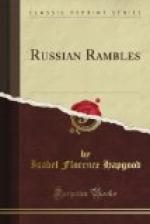The peculiarity of this Makary Fair is that nothing is sold by sample, in modern fashion; the whole stock of goods is on hand, and is delivered at once to purchasers. The taciturn, easy-going merchants in those insignificant-looking shops of the Gostinny Dvor “rows,” and, to a small extent, in the supplementary town which has sprung up outside the canal, set the prices for tea and goods of all sorts all over Russia and Siberia for the ensuing year. Contracts for the future are dated, and last year’s bills fall due, at “Makary.” It is hard to realize.
All the firms with whose shops we had been familiar in Petersburg and Moscow had establishments here, and, at first, it seemed not worth while to inspect their stocks, with which we felt perfectly acquainted. But we soon discovered that our previous familiarity enabled us to distinguish certain articles which are manufactured for the “Fair” trade exclusively, and which are never even shown in the capitals. For example, the great porcelain houses of St. Petersburg manufacture large pipe-bowls, ewers (with basins to match) of the Oriental shape familiar to the world in silver and brass, and other things, all decorated with a deep crimson bordering on magenta, and with gold. The great silk houses of Moscow prepare very rich and very costly brocades of this same deep crimson hue, besprinkled with gold and with tiny bouquets of bright flowers, or in which the crimson is prominent. They even copy the large, elaborate patterns from the robes of ancient Doges of Venice. All these, like the pipes and ewers, are made to suit the taste of customers in Bokhara and other Eastern countries, where a man’s rank is, to a certain degree, to be recognized by the number and richness of the khalati which he can afford to wear at one time. This is one of the points in which the civilization of the East coincides very nearly with the civilization of the West. The khalat is a sort of dressing-gown, with wide sleeves, which is girt about the waist with a handsome shawl; but it would strike a European that eight or ten of these, worn one on top of the other, might conduce to the preservation of vanity, but not to comfort, in the hot countries where the custom prevails. The Bokhariots bring to the Fair khalati of their own thin, strong silk, in hues more gaudy than those of the rainbow and the peacock combined, which are always lined with pretty green and white chintz, and can be bought for a very reasonable price in the Oriental shops, together with jeweled arms and ornaments, rugs, and a great variety of fascinating wares.




